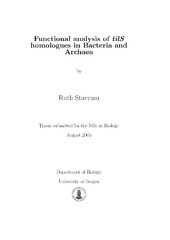Functional analysis of tilS homologues in Bacteria and Archaea
Master thesis
Permanent lenke
https://hdl.handle.net/1956/1139Utgivelsesdato
2005-09-09Metadata
Vis full innførselSamlinger
Sammendrag
Out of all of the microorganisms sequenced so far about one third of the genes have unknown function. Several studies have shown that information on evolutionary relationships between unknown genes can aid in the prediction of the function of these genes. As a result of all this new information, new methods of identification have been established which sort genes based on sequence similarity between both paralogues and orthologues genes. The Clusters of Orthologous Groups (COG) is one such method, which group genes on the basis of sequence similarity where all groups containing at least three proteins from distant genomes are assumed to belong to the same orthologous group. At the start of this project all, but one of the COGs containing universal genes had been assigned a function. In the last group, COG0037, the genes had been suggested to be ATPases based on conserved motifs. In September, 2003 an article was published where the function of one of the Escherichia coli members in COG0037, TilS (previously known as YaeN), had been determined and TilS was shown to be an RNA modification enzyme. Based on this knowledge it was decided to analyse TilS orthologues for similar function. In this work four TilS homologues; AF1595 and AF1321 from Archaeoglobus fulgidus, Sso0586 from Sulfolobus solfataricus and YdaO from E. coli were expressed in Escherichia coli, and tested for solubility. Out of the four proteins only one, YdaO proved to be soluble. This protein was purified by affinity chromatography and analysed further and shown to exhibit ATPase activity and ability to autophosphorylate. An attempt to verify whether this protein is expressed under normal conditions was unsuccessful. An attempt to determine whether the gene coding for YdaO could be used as a signature gene for E. coli was also unsuccessful.
Utgiver
The University of BergenOpphavsrett
The authorCopyright the author. All rights reserved
Copyright the author. All rights reserved
The author
